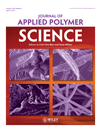Influence of the reactive processing of recycled poly(ethylene terephthalate)/poly(ethylene-co-glycidyl methacrylate) blends
Abstract
The effect of the amount of reactive additive and screw speed during extrusion on the morphological characteristics and mechanical performance of recycled poly(ethylene terephthalate)(RPET) was investigated. With an increase in the ethylene–glycidyl methacrylate copolymer (E–GMA) additive content, a gradual increase in the Izod impact strength of the RPET/E–GMA blends was initially recorded. Subsequent increases in the E–GMA content to above 13.5 wt % led to a drastic enhancement in the toughness of the blends. Meanwhile, the density of the blends decreased with increasing amount of the additive E–GMA. The toughness and density of the blends were found to be dependent on the screw rotation speed during the extrusion. In addition, ductile and microporous structures were observed on the Izod impact fracture surfaces. © 2010 Wiley Periodicals, Inc. J Appl Polym Sci, 2011




